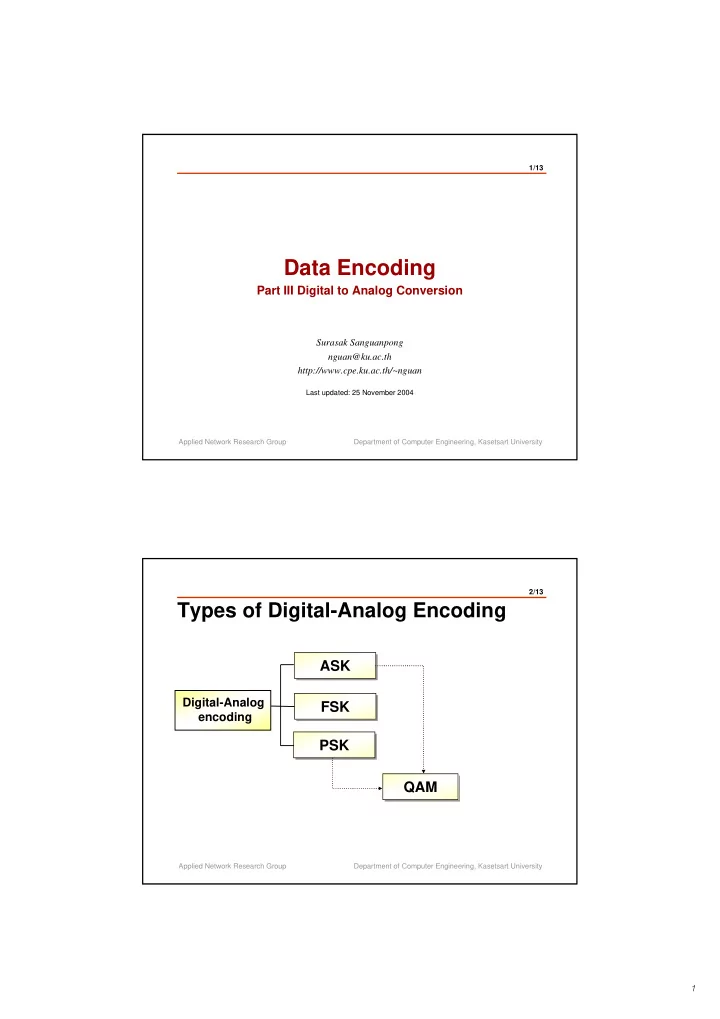

1/13 Data Encoding Part III Digital to Analog Conversion Surasak Sanguanpong nguan@ku.ac.th http://www.cpe.ku.ac.th/~nguan Last updated: 25 November 2004 Applied Network Research Group Department of Computer Engineering, Kasetsart University 2/13 Types of Digital-Analog Encoding ASK ASK Digital-Analog FSK FSK encoding PSK PSK QAM QAM Applied Network Research Group Department of Computer Engineering, Kasetsart University 1
3/13 Digital data, Analog signal � Transmitting digital data through PSTN � Modem is used to convert digital data to analog signal and vice versa Applied Network Research Group Department of Computer Engineering, Kasetsart University 4/13 Modulation techniques 0 0 1 1 0 1 0 0 0 1 0 ASK FSK PSK Applied Network Research Group Department of Computer Engineering, Kasetsart University 2
5/13 ASK 1 0 1 1 0 0 1 0 1 0 V d (t) V c (t) V ASK (t) Applied Network Research Group Department of Computer Engineering, Kasetsart University 6/13 FSK 1 0 1 1 0 0 1 v d (t) v 1 (t) Carrier 1 v 2 (t) Carrier 2 v FSK (t) Applied Network Research Group Department of Computer Engineering, Kasetsart University 3
7/13 PSK 1 0 1 1 0 0 1 Data v c (t) Signal Carrier v c (t) Phase coherent v PSK (t) 180=0 0=1 bit rate = signaling rate phase diagram Applied Network Research Group Department of Computer Engineering, Kasetsart University 8/13 4-PSK 1 0 1 1 0 0 1 1 0 1 1 0 0 1 Applied Network Research Group Department of Computer Engineering, Kasetsart University 4
9/13 Signal Constellation distance = C 2 +D 2 point defines a legitimate signal change C C sin -1 angle = C 2 +D 2 D � distance defines signal’s amplitude � angle defines phase shift Applied Network Research Group Department of Computer Engineering, Kasetsart University 10/13 N-PSK constellation diagram 4-PSK 8-PSK +90 ฐ =01 010 011 001 100 000 +180 ฐ =10 0 ฐ =00 101 111 110 +270 ฐ =11 bit rate = 2xsignaling rate bit rate = 3xsignaling rate Applied Network Research Group Department of Computer Engineering, Kasetsart University 5
11/13 Quadrature Amplitude Modulation 4-QAM 8-QAM 011 010 00 01 101 100 000 001 10 11 110 111 1 amplitude, 4 phases 2 amplitude, 4 phases Both amplitude and phase are combined Applied Network Research Group Department of Computer Engineering, Kasetsart University 12/13 16-ary QAM Sample of 16-ary QAM V.29 : WE 209 : 4 amplitudes 3 amplitudes 2 amplitudes 8 phases 12 phases 8 phases Applied Network Research Group Department of Computer Engineering, Kasetsart University 6
13/13 Bit rate and Baud rate � Bit rate : A number of bits that are transmitted in a second � Baud rate : A number of line signal changed variation per second If a modem transmits 1 bit for every signal change bit rate = baud rate If a signal change represents n bits bit rate = n*baud rate Applied Network Research Group Department of Computer Engineering, Kasetsart University 7
Recommend
More recommend